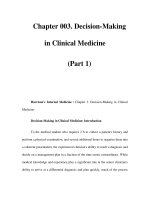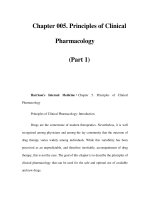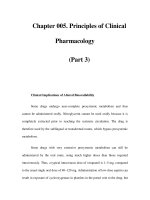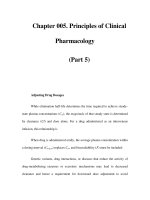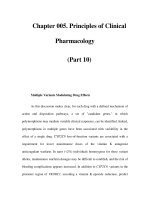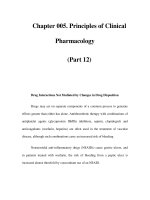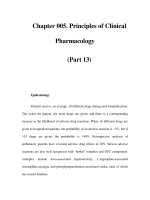Essentials of Clinical Research - part 1 doc
Bạn đang xem bản rút gọn của tài liệu. Xem và tải ngay bản đầy đủ của tài liệu tại đây (434.41 KB, 36 trang )
Essentials of Clinical Research
Stephen P. Glasser
Editor
Essentials of
Clinical Research
Editor
Stephen P. Glasser
University of Alabama at Birmingham
AL, USA
ISBN 978-1-4020-8485-0 e-ISBN 978-1-4020-8486-7
Library of Congress Control Number: 2008927238
© 2008 Springer Science + Business Media B.V.
No part of this work may be reproduced, stored in a retrieval system, or transmitted in any form or by any
means, electronic, mechanical, photocopying, microfilming, recording or otherwise, without written
permission from the Publisher, with the exception of any material supplied specifically for the purpose
of being entered and executed on a computer system, for exclusive use by the purchaser of the work.
Printed on acid-free paper
9 8 7 6 5 4 3 2 1
springer.com
Acknowledgements
The Fall Class of 2007 was asked to vet the majority of the chapters in this book,
and did an excellent job. Two students went above and beyond, and for that I would
like to acknowledge their contributions: John N. Booth III and Nina C. Dykes.
v
Contents
“Goals in writing are dreams with deadlines.” Brian Tracy antra
cytickets.com/brian-tracy-quotes.php
Acknowledgements v
Contributors xi
List of Abbreviations xiii
Part I
1 Clinical Research: Definitions, “Anatomy and Physiology,”
and the Quest for “Universal Truth” 3
Stephen P. Glasser
2 Introduction to Clinical Research
and Study Designs 13
Stephen P. Glasser
3 Clinical Trials 29
Stephen P. Glasser
4 Alternative Interventional Study Designs 63
Stephen P. Glasser
5 Postmarketing Research 73
Stephen P. Glasser, Elizabeth Delzell, and Maribel Salas
6 The United States Federal Drug Administration (FDA)
and Clinical Research 93
Stephen P. Glasser, Carol M. Ashton, and Nelda P. Wray
7 The Placebo and Nocebo Effect 111
Stephen P. Glasser and William Frishman
vii
8 Recruitment and Retention 141
Stephen P. Glasser
9 Data Safety and Monitoring Boards (DSMBs) 151
Stephen P. Glasser and O. Dale Williams
10 Meta-Analysis 159
Stephen P. Glasser and Sue Duval
Part II
11 Research Methods for Genetic Studies 181
Sadeep Shrestha and Donna K. Arnett
12 Research Methods for Pharmacoepidemiology Studies 201
Maribel Salas and Bruno Stricker
13 Implementation Research: Beyond the Traditional
Randomized Controlled Trial 217
Amanda H. Salanitro, Carlos A. Estrada, and Jeroan J. Allison
14 Research Methodology for Studies of Diagnostic Tests 245
Stephen P. Glasser
Part III
15 Statistical Power and Sample Size:
Some Fundamentals for Clinician Researchers 261
J. Michael Oakes
16 Association, Cause, and Correlation 279
Stephen P. Glasser and Gary Cutter
17 Bias, Confounding, and Effect Modification 295
Stephen P. Glasser
18 It’s All About Uncertainty 303
Stephen P. Glasser and George Howard
19 Grant Writing 317
Donna K. Arnett and Stephen P. Glasser
viii Contents
Part IV
20 The Media and Clinical Research 329
Stephen P. Glasser
21 Mentoring and Advising 335
Stephen P. Glasser and Edward W. Hook III
22 Presentation Skills: How to Present Research Results 341
Stephen P. Glasser
Index 351
Contents ix
Contributors
Jeroan J. Allison, MD, M.Sc.
Deep South Center on Effectiveness at the Birmingham VA Medical Center,
Birmingham, AL; Professor of Medicine, Assistant Dean for Continuing Medical
Education, UAB, University of Alabama at Birmingham, AL
Donna K. Arnett, Ph.D., MS, MPH
Professor and Chair of Epidemiology, Department of Epidemiology, School
of Public Health, University of Alabama at Birmingham, Birmingham, AL
Carol M. Ashton, MD, MPH
Professor of Medicine, Division of Preventive Medicine, Department of Internal
Medicine University of Alabama at Birmingham, Birmingham, AL
Gary Cutter, Ph.D.
Professor of Biostatistics, School of Public Health, University of Alabama
at Birmingham, Birmingham, AL
Elizabeth Delzell, Ph.D., D.Sc.
Professor of Epidemiology, Department of Epidemiology School of Public
Health, University of Alabama at Birmingham, Birmingham, AL
Sue Duval, Ph.D.
Assistant Professor Division of Epidemiology & Community Health, University
of Minnesota School of Public Health, Minneapolis, MN
Carlos A. Estrada, MD, MS
Veterans’ Administration National Quality Scholars Program, Birmingham VA
Medical Center, Birmingham, AL; Associate Professor of Medicine, University
of Alabama at Birmingham, AL; Deep South Center on Effectiveness at the
Birmingham VA Medical Center, Birmingham, AL
William Frishman, MD, M.A.C.P.
The Barbara and William Rosenthal Professor and Chairman, The Department
of Medicine, New York Medical College, New York City, NY
xi
Stephen P. Glasser,
Professor of Medicine and Epidemiology, Univesity
of Alabama at Birmingham, Birmingham, Alabama
1717 11th Ave. South MT 638, Birmingham AL
Edward W. Hook III, MD
Professor of Medicine, University of Alabama at Birmingham School
of Medicine and Medical Director, STD Control Program, Jefferson County
Department of Health, Birmingham, AL
George Howard, DrPH
Professor and Chair Department of Biostatistics School of Public Health,
University of Alabama at Birmingham, Birmingham, AL
J. Michael Oakes, Ph.D.
McKnight Presidential Fellow, Associate Professor of Epidemiology &
Community Health, University of Minnesota, School of Public Health,
Minneapolis, MN
Amanda H. Salanitro, MD, MS
Veterans’ Administration National Quality Scholars Program, Birmingham
VA Medical Center, Birmingham, AL
Maribel Salas, MD, D.Sc., M.Sc.
Assistant Professor at the Division of Preventive Medicine and Professor
of Pharmacoepidemiology, Department of Medicine and School of Public
Health, University of Alabama at Birmingham, Birmingham, AL.
Sadeep Shrestha, Ph.D., MHS, MS
Assistant Professor of Epidemiology, Department of Epidemiology, School
of Public Health, University of Alabama at Birmingham, Birmingham, AL
Bruno Stricker, MD, Ph.D.
Professor of Pharmacoepidemiology, Department of Epidemiology &
Biostatistics, Erasmus University Medical School, Rotterdam, and Drug Safety
Unit, Inspectorate for Health Care, The Hague, The Netherlands
O. Dale Williams, Ph.D., MPH
Professor of Medicine, Division of Preventive Medicine, University of Alabama
at Birmingham, Birmingham, AL
Nelda P. Wray, MD, MPH
Professor of Medicine, Division of Preventive Medicine, Department of Internal
Medicine, University of Alabama at Birmingham, Birmingham, AL
xii Contributors
List of Abbreviations
A Diabetes Outcome Prevention Trial = ADOPT
Absolute Risk Reduction = ARR
Acid Citrate Dextrose = ACD
Acute Myocardial Infarction Study = AMIS
Acute Respiratory Infections = ARI
Analysis of Variance = ANOVA
Area Under Curve = AUC
Attributable Risk = AR
Biological License Applications = BLA
Calcium Channel Blocker = CCB
Canadian Implantable Defibrillator Study = CIDS
Cardiac Arrhythmia Suppression Trial = CAST
Case-Control Study = CCS
Cholesterol and Recurrent Events = CARE
Clinical Trial of Reviparin and Metabolic Modulation of Acute Myocardial
Infarction = CREATE
Computerized Provider Order Entry = CPOE
Consolidated Standards of Reporting Trials = CONSORT
Continuing Medical Education = CME
Controlled Onset Verapamil INvestigation of Cardiovascular Endpoints =
CONVINCE
Coronary Heart Disease = CHD
Cross Sectional = X-sectional
Data Safety and Monitoring Board = DSMB
Data Safety and Monitoring Plan = DSMP
Deep Venous Thrombosis = DVT
Department of Health, Education and Welfare = HEW
Diltiazem LA = DLA
Division of Drug Marketing and Communications (DDMAC)
Drug Efficacy Study Implementation = DESI
Electromagnetic Energy = EME
Electron Beam Computed Tomography = EBCT
Emergency Medical Technician = EMT
xiii
Ethical, Legal, and Social Implications = ELSI
Ethylenediaminetetraacetic = EDTA
European Medicines Agency = EMEA
Evidence based Medicine = EBM
False Positive = FP
False Negative = FN
Food and Drug Administration = FDA
Good Clinical Practice = GCP
Good Medical Practice = GMP
Health Insurance Portability and Accountability Act = HIPPA
Health Maintenance Organizations = HMO
Hormone Replacement Therapy = HRT
Individual Patient Data = IPD
Institute of Medicine = IOM
Institutional Review Board = IRB
Intention to Treat = ITT
International Committee of Medical Journal Editors = ICMJE
International Conference on Harmonization = ICH
Intra-class Correlation Coefficient = ICC
Investigational New Drug = IND
Large Simple Trials = LST
Left Ventricular = LV
Linkage Disequilibrium = LD
Lung Volume Reduction Surgery = LVRS
Manual of Operations = MOOP
Multicenter Investigation of Limitation of Infarct Size = MILIS
Multicenter Isradispine Diuretic Atherosclerosis Study = MIDAS
Multiple Risk Factor Intervention Trial = MRFIT
Myocardial Infarction = MI
National Institutes of Health = NIH
Needed to Harm = NNH
Needed to Treat = NNT
New Drug Application = NDA
Nonsteroidal Antiinflamatory Drugs = NSAID
Number Needed to Treat = NNT
Odds Ratio = OR
Patient Oriented Research = POR
Pay for Performance = P4P
Pharmacoepidemiology = PE
Pharmacokinetics = PK
Physician Experience Studies = PES
Post Marketing Commitment Studies = PMCs
Premature Ventricular Contractions = PVCs
Principal Investigator = PI
Prospective, Randomized, Open-label, Blinded End-point = PROBE trial
xiv List of Abbreviations
Protected Health Information = PHI
Randomized Clinical Trial = RCT
Receiver Operator Characteristic Curves = ROC curve
Regression Towards Mediocrity = RTM
Relative Risk Reduction = RRR
Relative Risk = RR
Risk Difference = RD
Rural Diabetes Online Care = RDOC
Specific, Measurable, Appropriate, Realistic Time Bound = SMART
Stroke Prevention by Aggressive Reduction in Cholesterol Levels = SPARCL
Sudden Cardiac Death = SCD
The International Conference on Harmonization = ICH
The Myocardial Ischemia Reduction with Aggressive Cholesterol Lowering =
MIRACL
The Pharmaceutical Research and Manufacturers of America = PhRMA
The Prescription Drug User Fee Act = PDUFA
The Strengthening and Reporting of Observational Studies in Epidemiology =
STROBE
True Positive = TP
True Negitive = TN
U.S. National Health and Nutrition Examination Survey = NHANES
Unintended Adverse Events = UAEs
United States Federal Drug Administration = USFDA
Valsartin/Hydrochlorthiazide = VAL/HCTZ
Ventricular Premature Complexes = VPCs
White Blood Count = WBC
Woman’s Health Initiative = WHI
List of Abbreviations xv
Part I
This Part addresses traditional clinical research, beginning with the history of the
development of clinical research, to traditional clinical research designs, with a
focus on clinical trials. It includes a discussion of the role of the USFDA in clinical
trials and the placebo response, data safety and monitoring boards, and
meta-analysis.
When I re-read, I blush, for even I perceive enough that ought
to be erased, though it was I who wrote the stuff.
Ovid, Roma Poet as cite in Breslin JE etc. p 444
Chapter 1
Clinical Research: Definitions, “Anatomy
and Physiology,” and the Quest for “Universal
Truth”
1
Stephen P. Glasser
Scientific inquiry is seeing what everyone else is seeing, but
thinking of what no one else has thought.
A. Szentgyorgyi, 1873 (he won the Nobel Prize for isolating
Vitamin C)
2
Abstract To answer many of their clinical questions, physicians need access
to reports of original research. This requires the reader to critically appraise the
design, conduct, and analysis of each study and subsequently interpret the results.
This first chapter reviews some of the key historical developments that have led to
the current paradigms used in clinical research, such as the concept of randomization,
blinding (masking) and, placebo-controls.
Introduction
As a former director of a National Institutes of Health (NIH)-funded K30 program,
it was my responsibility to provide a foundation for young researchers to become
independent principal investigators. A part of our curriculum was a course entitled
‘The Fundamentals of Clinical Research.’ This course, in addition to guiding stu-
dents, was also designed to aid ‘students’ who wanted to read the medical literature
more critically. This latter point is exemplified by the study of Windish et al.
3
They
note that “physicians must keep current with the clinical information to practice
evidence-based medicine…. To answer many of their clinical questions, physicians
need access to reports of original research. This requires the reader to critically
appraise the design, conduct, and analysis of each study and subsequently interpret
the results.”
3
Although aimed at physicians, this observation can and should be
applied to all health scientists who must read the literature in order to place the
results in context. The Windish study surveyed 277 completed questionnaires that
assessed knowledge about biostatistics, and study design. The overall mean percent
correct on statistical knowledge and interpretation of results was 41.4%.
It is my belief that the textbooks currently available are epidemiologically
“slanted”. There is nothing inherently wrong with that slant, but I have written this
book to be more specifically geared to the clinical researcher interested in conducting
S.P. Glasser (ed.), Essentials of Clinical Research, 3
© Springer Science + Business Media B.V. 2008
4 S.P. Glasser
Patient Oriented Research (POR). In this first chapter I will provide a brief overview
of the history of clinical research. The chapter will also address the question of why
we do clinical research; define ‘clinical research’; discuss our quest for ‘universal
truth’ as the reason for doing clinical research; outline the approach taken to answer
clinical questions; and describe (as Hulley an colleagues so aptly put it) ‘the anat-
omy and physiology of clinical research.’
1
Future chapters will examine such issues as causality (i.e., causal inference or
cause and effect); the strengths and weaknesses of the most popular clinical
research designs; regression to the mean; clinical decision making; meta-analysis;
and the role of the Food and Drug Administration (FDA) in the clinical trial proc-
ess. We will also focus on issues related to randomized clinical trials, such as the
intention-to-treat analysis, the use and ethics of placebo-controlled trials, and sur-
rogate and composite endpoints.
Definition of Clinical Research
The definition of clinical research might appear to be self-evident; however, some
researchers have narrowly defined clinical research to refer to clinical trials (i.e.,
intervention studies in human patients), while others have broadly defined it as any
research design that studies humans (patients or subjects) or any materials taken from
humans. This latter definition may even include animal studies, the results of which
more or less directly apply to humans. For example, in 1991, Ahrens included the
following in the definition of clinical research: studies on the mechanisms of human
disease; studies on the management of disease; in vitro studies on materials of human
origin; animal models of human health and disease; the development of new technol-
ogies; the assessment of health care delivery; and field surveys.
4
In an attempt to sim-
plify the definition, some wits have opined that clinical research occurs when the
individual performing the research is required to have malpractice insurance, or when
the investigator and the human subject are, at some point in the study, in the same
room, and both are alive and warm. So, there is a wide range of definitions of clinical
research, some valid, some not. I have chosen to adopt a ‘middle of the road’ defini-
tion that encompasses the term ‘patient-oriented-research,’ which is defined as
research conducted with human subjects (or on material of human origin) for which
the investigator directly interacts with the human subjects at some point during the
study. It is worth noting that this definition excludes in vitro studies that use human
tissue that may or may not be linked to a living individual unless the investigator dur-
ing the conduct of the trial has significant interaction with a living breathing human.
History of Clinical Research
Perhaps the first clinical trial results were those of Galen (circa 250 bc) who con-
cluded that ‘some patients that have taken this herbivore have recovered, while some
have died; thus, it is obvious that this medication fails only in incurable diseases.’
1 Clinical Research: Definitions, “Anatomy and Physiology” 5
Galen’s observations underline the fact that even if we have carefully and appropriately
gathered data, there are still subjective components to its interpretation, indicating
our quest for ‘universal truth’ is bedeviled more by the interpretation of data than
by its accumulation.
James Lind is generally given credit for performing and reporting the first pla-
cebo-controlled interventional trial in the treatment and prevention of scurvy. In the
1700s, scurvy was a particularly vexing problem on the long voyages across the
Atlantic Ocean. The research question that presented itself to Lind was how to pre-
vent the condition. To arrive at an answer, Lind did what every good researcher
should do as the first step in converting a research question into a testable hypothe-
sis – he reviewed the existent literature of the time. In so doing, he found a report
from 1600 that stated ‘1 of 4 ships that sailed on February 13th, 1600, was supplied
with lemon juice, and almost all of the sailors aboard the one ship were free of
scurvy, while most of the sailors of the other ships developed the disease.’ On the
one hand, Lind’s job was easy-there was not a great deal of prior published works.
On the other hand, Lind did not have computerized searches via Med Line, Pub
Med etc. available.
As a result of the above, in 1747, Lind set up the following trial. He took 12
patients ‘in the scurvy’ on board the HMS Salisbury. ‘These cases were as similar
as I could have them….they lay together in one place … and had one diet common
to all. The consequence was that the most sudden and visible good effects were
perceived from the use of oranges and lemons.’ Indeed, Lind evaluated six treat-
ment groups: ‘One group of two was given oranges and lemons. One of the two
recovered quickly and was fit for duty after 6 days, while the second was the best
recovered and was assigned the role of nurse for the remaining patients.’ The other
groups were each treated differently and served as controls. If we examine Lind’s
‘study’ we find a number of insights important to the conduct of clinical trials as
follows. For example, Lind noted that ‘on the 20th May, 1747, I took twelve
patients in the scurvy on board the Salisbury at sea… Their cases were as similar
as I could have them. They all in general had putrid gums, the spots and lassitude,
with weakness of their knees…’ here Lind was describing eligibility criteria for his
study. He continues, ‘…They lay together in one place, being a proper apartment
for the sick in the fore-hold; and had one diet in common to all…’ ‘… Two of these
were ordered each a quart of cyder a day. Two others took twenty five gutts of elixir
vitriol three times a day upon an empty stomach,
… Two others took two spoonfuls of vinegar three times a day
… Two … were put under a course of sea water.
… Two others had each two oranges and one lemon given them every day.
… The two remaining patients took the bigness of a nutmeg three times a day.’
By this description, Lind described the interventions and controls. To continue, ‘…
The consequence was that the most sudden and visible good effects were perceived
from the use of the oranges and lemons; one of those who had taken them being at
the end of six days fit four duty. The spots were not indeed at that time quite off his
body, nor his gums sound; but without any other medicine than a gargarism or elixir
of vitriol he became quite healthy before we came into Plymouth, which was on the
6 S.P. Glasser
16th June.’ This latter description represents the outcome parameters and interpre-
tation of his study. In summary, Lind addressed the issues of parallel-group design
and the use of control groups, and he attempted to assure similarity between the
groups except for the intervention.
Clearly, sample size considerations and randomization were not used in Lind’s
trial, but this small study was amazingly insightful for its time. Other selected mile-
stones in the history of clinical research include:
●
Fisher’s introduction of the concept of randomization in 1926.
5
●
The announcement in 1931 by the Medical Research Council that they had
appointed ‘a therapeutics trials committee…to advise and assist them in arrang-
ing for properly controlled clinical tests of new products that seem likely on
experimental grounds to have value in the treatment of disease’.
6
●
Amberson and colleagues’ introduction of the concept of ‘blindness’ in clinical
trials
6
and their study of tuberculosis patients where the process of randomiza-
tion was applied.
7
They noted that after careful matching of 24 patients with
pulmonary tuberculosis, the flip of a coin determined which group received the
study drug.
7
Further analysis of the tuberculosis streptomycin study of 1948 is regarded as
the beginning of the modern era of clinical research and is instructive in this
regard. In the 1940s tuberculosis was a major public health concern, and rand-
omization was being recognized as a pivotal component to reduce bias in clinical
trials.
8
As a result the Medical Research Council launched a clinical trial in
which 55 patients were randomized to treatment with bed rest (the standard of
care treatment at that time) and 52 were treated with bed rest alone. In Fig. 1.1
one can read Professor Bradford Hill’s insightful description of the randomiza-
tion process.
9
Other significant developments include reference to the use of saline solution in
control subjects as a placebo, and the requirement in 1933 that animal toxicity stud-
ies be performed before human use.
8
In the 1940s, the Nuremberg Code, the
Declaration of Helsinki, the Belmont Report, and the doctrine of Good Clinical
Practice (GCP) were developed, which will be discussed in more detail later. As
mentioned above, In 1948, the Medical Research Council undertook a streptomycin
study
9
which was perhaps the first large-scale clinical trial using a properly
designed randomized schema. This was followed by an antihistamine trial that used
a placebo arm and double-blind (masked) design.
10
In 1954, there were large-scale polio studies – field trials of 1.8 million school-
age children. A controversy regarding the best design resulted in two trials, one
design in which some school districts’ second graders received the dead virus vac-
cine while first and third graders acted as the controls; and another design in which
second graders randomly received either the vaccine or a saline injection. Both
studies showed a favorable outcome for the vaccine (Fig. 1.2).
In 1962, the thalidomide tragedy became widely known and resulted in the tight-
ening of government regulations. The story behind this tragedy is instructive. By
1960, thalidomide worldwide was being sold, but not in the United States. At the
1 Clinical Research: Definitions, “Anatomy and Physiology” 7
time, the prevailing US law was the 1938 Federal Food, Drug, and Cosmetic Act,
which required proof of safety be sent to the FDA before a medication could be
approved for sale in the United States. The law did not require demonstration of effi-
cacy for approval. It also allowed “investigational” or “experimental” use of a drug
while approval for its sale was being sought, allowing a medication to be widely dis-
tributed prior to approval. The application for the USA use was given to Frances
Kelsey who noted a lack of teratogenicity data, and she also had other worries about
thalidomide. As a result, Kelsey rejected the application and requested additional data
from the company, but the company complained to her superiors that she was nit-
picking and unreasonable. Kelsey continued to refuse to approve thalidomide for sale
in the United States, and in total, the company resubmitted its application to the FDA
six times, but with no new evidence in those applications Kelsey refused approval.
Fig. 1.1 From the British Medical Journal, Sir Bradford Hill’s description of the randomization
process
8 S.P. Glasser
Subsequently, reports regarding a number of birth defects were reported and the drug
was removed worldwide, thereafter.
11
As mentioned prior, at the time of the thalidomide disaster, trials of new drugs
were required to prove safety but not efficacy as described under the FDA’s 1938
Act. As a result of the disaster, tightening of the regulations was instituted and trials
were to have an ‘adequate and well-controlled design’ before approval of any new
drug. This was followed by the Drug Efficacy Study Implementation (DESI) review
and the FDA’s development of the four stages of clinical trials necessary for new
drug approval, which set the stage for today’s process of drug approval.
In the 1970s and 1980s, clinical research was prospering, but by the 1990s there
began a decline in the number of new clinical investigators. This trend caught the
eye of a number of academicians and the NIH, which then commissioned the
Institute of Medicine (IOM) to address ways to stimulate individuals to pursue
careers in clinical investigation, to define appropriate curricula for training, and to
ensure adequate support mechanisms for retaining clinical researchers.
The NIH also developed granting mechanisms for supporting individual clinical
investigators at various levels of their careers (K23 and K24 grants) and for pro-
grammatic support of institutions that developed clinical research training programs
(K30 grants). The IOM report documented the decline in clinical investigators
(particularly MD investigators), and noted that the time commitment necessary to
do clinical research was underappreciated.
12
Recently, DeMets and Califf noted, ‘we are entering an era in which the impera-
tive to understand the rational basis for diagnostic and therapeutic options has
become a major force in medical care.’ Medical products (drugs, devices, and
Poliomyelitis Vaccine Trials
Study Outcome
0
10
20
30
40
50
60
70
80
Vaccine Placebo Vaccine Placebo
Rate (per 100,000)
Non-Paralytic
Paralytic
Observational Study Placebo Trial
Observational Study Placebo Trial
Fig. 1.2 Results form the use of polio vaccines used in both an observational trial and a placebo
controlled clinical trial
1 Clinical Research: Definitions, “Anatomy and Physiology” 9
biologics) are proliferating simultaneously with substantial restructuring of the
delivery of health care, with a focus on evidence to support medical
intervention.
13
Today, we are left with the ‘good, the bad, and the ugly’ regarding clinical
research. The ‘good’ is that many experts think that sound comprehension of the
scientific method and exposure to biomedical research comprise the essential core
of medical education, and that the very essence of the American academic model is
a balance between education, patient care, and research. The ‘bad’ is the increasing
number of voices questioning the relevancy of research in academic health centers,
as well as those concerned about the commitment to other components of training
and the cost of research in a setting where the ‘triple threat’ (i.e., excelling in teach-
ing, patient care, and research) may no longer be tenable given the increasing com-
plexity of each area. The ‘ugly’ is that in 2003 only about 3 cents of every health
care dollar was spent on medical research; and, it was estimated that only 5% of
Congress could be counted on to take the initiative and be leaders in the support of
clinical research; and few potential investigators were being supported to pursue
careers or were given enough time to conduct research. By and large, these same
issues persist today.
With the above background, how do we begin our quest for knowledge? In gen-
eral, research questions are generated in a variety of settings (e.g., during journal
reading, hospital rounds, discussions with colleagues, seminars, and lectures). The
resultant questions can then be refined into a research idea and, after further review
of the literature, ultimately developed into a hypothesis. Based on a number of fac-
tors (to be discussed in subsequent issues), a study design is chosen, and the study
is then preformed and analyzed, the results of which are then interpreted and syn-
thesized. These results add to the body of knowledge, and this may raise additional
questions that will invariably generate further research (Fig. 1.3).
General Aspects of the Scientific Method In Planning or
Implementing a Study
General Aspects of the Scientific Method In Planning or
Implementing a Study
Question
Design
Conduct
Analysis
Result
Interpretation
Synthesis
Significance
Belief
Action
Fig. 1.3 General aspects of the
scientific method in planning or
implementing a study
10 S.P. Glasser
Of course, the primary goal of clinical research is to minimize presumption and
to seek universal truth. In fact, in science, little if anything is obvious, and the inter-
pretation of results does not mean truth, but is really an opinion about what the
results mean. Nonetheless, in our quest for universal truth, Hully and colleagues
have diagrammed the steps that are generally taken to seek this ‘truth’ (Fig. 1.4).
1
These latter concepts will be discussed in subsequent chapters. Finally, it should be
realized that clinical research can encompass a broad range of investigation as por-
trayed in Fig. 1.5.
Designing and Implementing a Project
Study
Study
Findings
Findings
Truth in
Truth in
the Study
the Study
Universal
Universal
Truth
Truth
Research
Research
Question
Question
Study
Study
Plan
Plan
Actual
Actual
Study
Study
Design
Design
Implement
Implement
External
External
validity
validity
Internal
Internal
validity
validity
Drawing
Drawing
Conclusions
Conclusions
Designing &
Designing &
Implementing
Implementing
Infer
Infer
Infer
Infer
Anatomy
Anatomy
Physiology
Physiology
Sampling,
Sampling,
Inclusions,
Inclusions,
Exclusions
Exclusions
Chance, Bias,
Chance, Bias,
Confounding
Confounding
Measurement
Measurement
Power
Power
Sample Size
Sample Size
Causality
Causality
Fig. 1.4 Designing and implementing a project
The Clinical Research Bridge
Genetic
Genetic
markers
markers
Descriptive & Ecologic studies
Descriptive & Ecologic studies
Case
Case
control
control
studies
studies
Cohort
Cohort
studies
studies
Clinical trials
Clinical trials
Intervention with
Intervention with
high
high
-
-
risk groups
risk groups
Policy
Policy
Community intervention
Community intervention
Methodological studies
Methodological studies
Markers of exposure
Markers of exposure
Other markers
Other markers
of risk
of risk
Biology
Biology
Prevention
Health promotion
Prevention
Health promotion
Fig. 1.5 Portrays the broad range that encompasses the term “clinical research”
1 Clinical Research: Definitions, “Anatomy and Physiology” 11
References
1. Hulley S, Cummings S, Browner Wea. Designing Clinical Research. 2nd ed. Philidelphia, PA:
Lippincott, Williams & Wilkins; 2000.
2. szentgyorgyi.html
3. Windish DM, Huot SJ, Green ML. Medicine residents’ understanding of the biostatistics and
results in the medical literature. JAMA. Sept 5, 2007; 298(9):1010–1022.
4. Ahrens E. The Crisis in Clinical Research: Overcoming Institutional Obstacles. New York:
Oxford University Press; 1992.
5. Fisher R. The Design of Experiments. Edinburgh: Oliver & Boyd; 1935.
6. Hart PD. Randomised controlled clinical trials. BMJ. May 25, 1991; 302(6787):1271–1272.
7. Amberson JB, MacMahon BT, Pinner M. A clinical trial of sanocrysin in pulmonary tubercu-
losis. Am Rev Tuber. 1931; 24:401–435.
8. Hill AB. The clinical trial. Br Med Bull. 1951; 7(4):278–282.
9. White L, Tursky B, Schwartz G. Placebo: Theory, Research, and Mechanisms. New York:
Guilford Press; 1985.
10. Medical Research Council. Streptomycin treatment of pulmonary tuberculosis. BMJ 1948;
ii:769–782.
11. Thalidomide. />12. Institute of Medicine. Careers in Clinical Research: Obstacles and Opportunities. Washington,
DC: National Academy Press; 1994.
13. DeMets DL, Califf RM. Lessons learned from recent cardiovascular clinical trials: Part I.
Circulation. Aug 6, 2002; 106(6):746–751.
Chapter 2
Introduction to Clinical Research
and Study Designs
Stephen P. Glasser
To educate is to guide students on an inner journey toward
more truthful ways of seeing and being in the world.
Parker J. Palmer
1
Abstract This chapter addresses some of the central concepts related to clinical
research and what is meant by the strength of scientific evidence. We also begin to
discuss the different clinical research designs along with their respective strengths
and weaknesses.
Sampling
An essential characteristic and the goal of any clinical research are to make infer-
ences from the population under study (the sample or study population) and apply
those inferences to a broader population (the target population i.e. the population
about which we want to draw conclusions). Imagine if the investigator could only
learn about and apply the results in the sample population? Rather we must be able
to extrapolate the results of the findings in the sample population to a broader group
of patients-otherwise the results would have no utility at all. Thus, one of the most
important weaknesses of any study is that inferences drawn from a study are based
on a limited sample (again, a sample is a select subset of a population that the
investigator hopes represents the general population, but which is unlikely to do
so). This limitation is further compounded by the fact that disease is not distributed
randomly, whereas samples tend to be, and that the causes of disease are multifacto-
rial. Ideally, when performing clinical research, we would like to include everyone
in our study who has the disease of interest. Because this is impossible we settle for
a sample of the diseased population, however, the researcher now has to deal with
a degree of uncertainty (see Chapter 18). Because different samples contain different
people with different co-morbidities, and differing experiences, we end up with
different data. The question now facing the researcher is which data from which
sample is most representative of the entire population? Sampling errors commonly
result in Type I and II errors. For example, if the researcher finds a certain effect of
S.P. Glasser (ed.), Essentials of Clinical Research, 13
© Springer Science + Business Media B.V. 2008
14 S.P. Glasser
an interventional therapy, the question to be asked is ‘how likely is it that this ther-
apy observation that was made from this sample is falsely representing the total
population (in which there was in fact no therapy effect)? This potential false result
is Type I error and is addressed by the p value. The reverse situation is a total popu-
lation that in fact has a therapy effect, but the sample studied shows no such effect.
This is the Type II error.
The Linear-Semilinear Relationship of Biological Variables
Another important concept of clinical research is the fact that most, if not all
biological variables have a linear–semilinear relationship in terms of exposure
and outcomes, whereas clinical medicine is replete with the use of ‘cut-
points’ to separate normal and abnormal or effect and no effect (Fig. 2.1). A
cut-point presumes that there is some value or range of values that separates
normal form abnormal rather than considering that the relationships tend to
be on a continuum.
Strength of Relationships
Another important issue in clinical research relates to what we mean when we talk
about ‘the strength of evidence.’ The greatest strength of evidence is often attrib-
uted to the randomized clinical trial (RCT). In fact, in response to the question of
what is the best clinical research design, the answer generally given is ‘the RCT,’
when in fact the correct answer should be ‘it depends,’ an answer which will be
0
10
20
30
40
50
60
70
80
90
100
Risk
Fig. 2.1a Epidemiological view of determining risk

